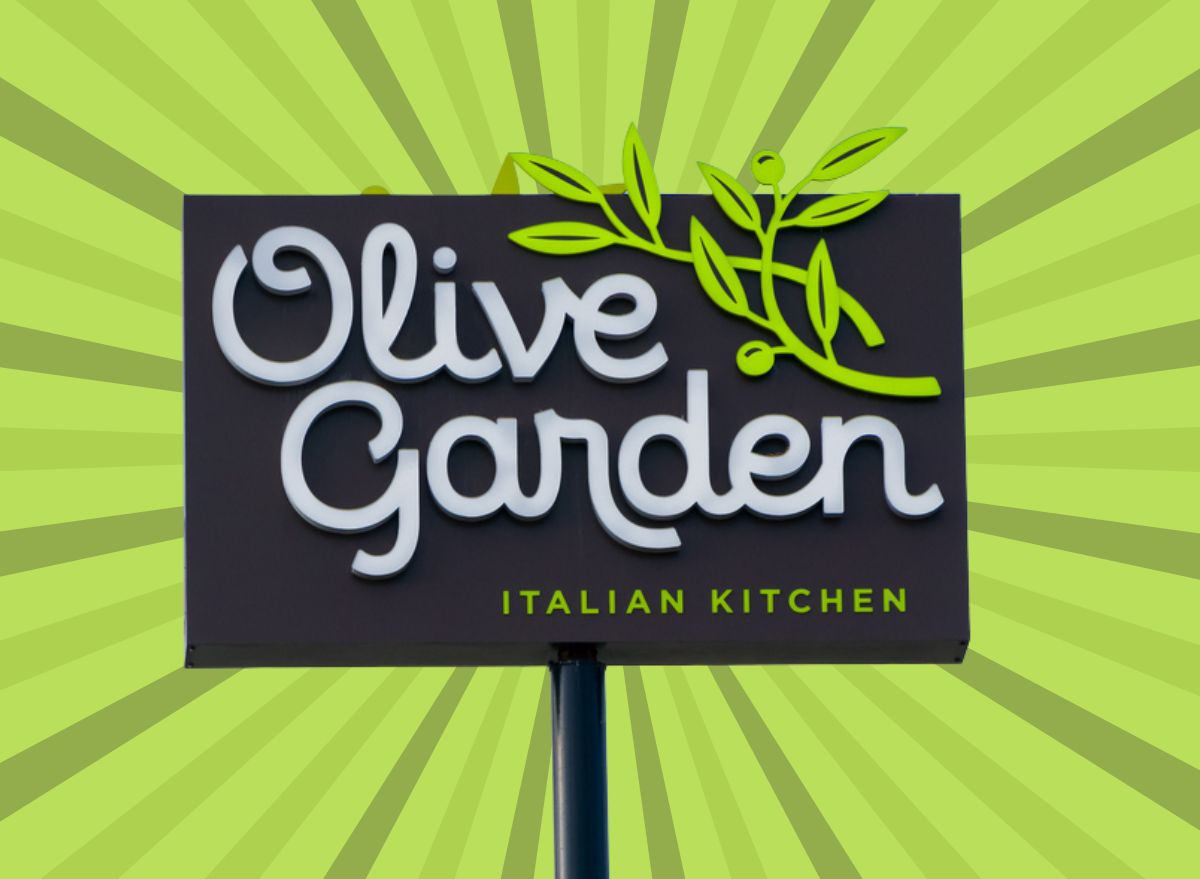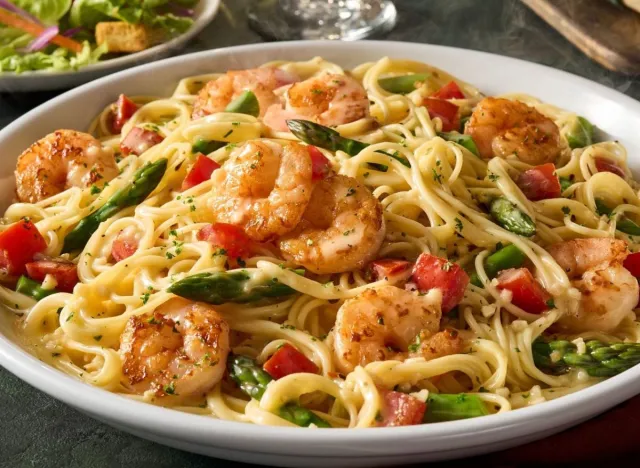The #1 Healthiest Order at Olive Garden, According to a Dietitian

What's not to love about the Olive Garden? Variety, accessibility, and hearty portions make this Italian-American chain so beloved, not to mention the endless salad and breadsticks that add the perfect flourish to any meal. Of course, with so much to choose from, there's bound to be certain dishes that top the nutrition charts while others lag behind, fraught with unnecessary saturated fats and sodium. But thankfully, some Olive Garden menu items are on the healthier side.
It's a mistake to think that everything at the Olive Garden comes smothered in cream sauces, salt, and mountains of parmesan cheese. Like with any world cuisine, there are always healthier options waiting to be discovered. And if you're a pasta lover (who isn't?), it's good to get a heads-up on what's healthiest before opening Olive Garden's novel-sized menu. Plus, on an empty stomach, those calorie-laden options can look pretty enticing.
We scrolled the Olive Garden menu and dove into the nutritional nitty-gritty to find which pasta dish will best fuel your body the next time you've got that unshirkable craving. Our pick may not be surprising to many folks, but the why may not be so well known.
Read on to learn about the healthiest Olive Garden menu item, then check out which dish to avoid with The #1 Unhealthiest Olive Garden Order.
The best order at Olive Garden is…the Shrimp Scampi

Calories: 490
Fat: 18 g (Saturated fat: 7 g)
Sodium: 1,120 mg
Carbs: 52 g (Fiber: 4 g, Sugar: 5 g)
Protein: 29 g
The Shrimp Scampi is the most nutritious pasta dish on the Olive Garden menu, as it clocks in under 500 calories and comes with heart-healthy produce like asparagus and tomatoes, all seasoned with a light garlic sauce.
Compared to other pasta dishes, this Shrimp Scampi contains half the sodium and fat counts, while still offering ample protein to help you leave the table full and satisfied. Additionally, this dish is low in sugar while also providing fiber to help keep you regular.
There's no doubt that this dish stands well above the rest, and even the Olive Garden menu dubs their Shrimp Scampi, "a lighter taste on a classic." This dish is certainly worth considering if you're hoping to be health-conscious yet also indulge in a pasta dish with the rest of your party.
The benefits of the Olive Garden Shrimp Scampi
This pasta dish is the healthiest choice on Olive Garden's menu for numerous reasons.
Lower in calories than other mains
For the average healthy adult, caloric intake averages around 2,000 calories per day. Three meals a day—and around 1-2 snacks—comes to about 500-600 calories per meal. Olive Garden's Shrimp Scampi perfectly aligns with this average, as it contains just below 500 calories and leaves room for a bit of Olive Garden salad to satisfy that craving.
Lower in fat than other mains
This dish contains 18 grams of fat, 7 grams of which are saturated. While these nutritionals may not seem Grade-A, this pasta dish constitutes half (or less) of the fat found in other dishes such as the Chicken Tortelloni Alfredo. There will inevitably be fat involved in a dish that comes tossed in a buttery garlic sauce, but this is a much lighter option than cream-based sauces that are heaped with rich cheeses. Additionally, this dish only contains only 0.5 grams of trans fat which, as excessive consumption of trans fats can lead to serious cardiovascular disease, is ideal.
Lower in sodium than other mains
When it comes to sodium counts, this dish's 1,120 milligrams is half the level of other pasta dishes and clocks in under the AHA's recommended daily allowance of 2,300 milligrams per day (or 1,500 milligrams per day for those experiencing hypertension, or high blood pressure). That being said, it's important to limit your consumption of add-on foods such as breadsticks, which are laden with fat and sodium that will have you exceeding your recommended daily limits quickly and without warning.
Good source of seafood
Per the Dietary Guidelines for Americans, most adults are not eating the recommended servings of seafood every week. Most adults should shoot for 8-12 ounces of seafood every week, depending on their overall calorie needs. The shrimp helps you meet your seafood quota while giving your body a tiny boost of omega-3 fatty acids.
Pasta is lower on the glycemic index
While the portion size is likely larger than what is typically recommended, including pasta in this dish isn't the worst thing in the world. Unlike many other refined grains (like donuts and white bread), pasta has a unique protein structure that makes it have a low glycemic index, potentially helping support healthy blood sugars. It is free from added salt and added sugar, and many varieties are typically enriched with important nutrients, like folic acid.
Good source of protein
Lastly, this dish offers ample protein at 29 grams, which may help you stay satiated until your next meal. Increased satiety through high-protein meals can help with weight maintenance as it reduces urges to snack in between meal times.
Whether you're ordering the lunch or dinner portion, this dish may be your best option if you're looking for a well-rounded, balanced meal. Add a bit of salad to the side, and you'll be consuming a wide variety of nutrients to fuel your body.
- Source: Iqbal MP. Trans fatty acids - A risk factor for cardiovascular disease. Pak J Med Sci. 2014 Jan;30(1):194-7. doi: 10.12669/pjms.301.4525. PMID: 24639860; PMCID: PMC3955571.
- Source: How much sodium should I eat per day? (2024e, January 5). www.heart.org. https://www.heart.org/en/healthy-living/healthy-eating/eat-smart/sodium/how-much-sodium-should-i-eat-per-day
- Source: Home | Dietary guidelines for Americans. (n.d.). https://www.dietaryguidelines.gov/
- Source: FoodData Central. (n.d.-cv). https://fdc.nal.usda.gov/fdc-app.html#/food-details/175179/nutrients
- Source: Sanders LM, Slavin J. Impact of Pasta Intake on Body Weight and Body Composition: A Technical Review. Nutrients. 2023 Jun 9;15(12):2689. doi: 10.3390/nu15122689. PMID: 37375591; PMCID: PMC10300797.
- Source: Moon J, Koh G. Clinical Evidence and Mechanisms of High-Protein Diet-Induced Weight Loss. J Obes Metab Syndr. 2020 Sep 30;29(3):166-173. doi: 10.7570/jomes20028. PMID: 32699189; PMCID: PMC7539343.









